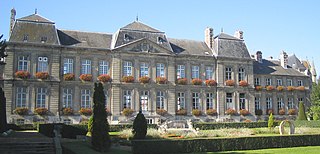
Edward Donald Slovik was a United States Army soldier during World War II and the only American soldier to be court-martialled and executed for desertion since the American Civil War. Although over 21,000 American soldiers were given varying sentences for desertion during World War II, including 49 death sentences, Slovik's death sentence was the only one that was carried out.

Soissons is a commune in the northern French department of Aisne, in the region of Hauts-de-France. Located on the river Aisne, about 100 kilometres (62 mi) northeast of Paris, it is one of the most ancient towns of France, and is probably the ancient capital of the Suessiones. Soissons is also the see of an ancient Roman Catholic diocese, whose establishment dates from about 300, and it was the location of a number of church synods called "Council of Soissons".

The First Battle of the Marne or known in France as the Miracle on the Marne was a battle of the First World War fought from 5 to 12 September 1914. The German army invaded France with a plan for winning the war in 40 days by occupying Paris and destroying the French and British armies (Allies/Entente). The Germans had initial successes in August. They were victorious in the Battles of Mons and the Frontiers and overran a large area of northern France and Belgium. In what is called the Great Retreat the Germans pursued the retreating Franco/British forces more than 250 km (160 mi) southward. The French and British halted their retreat in the Marne River valley while the Germans advanced to 40 km from Paris.

Johann "Hans" Theodor von Ravenstein was a German general (generalleutnant) in the Wehrmacht during World War II. He commanded the 21st Panzer Division from May 1941 until being made a prisoner of war in late November 1941. He was a recipient of the Knight's Cross of the Iron Cross.

The Second Battle of the Aisne was the main part of the Nivelle Offensive, a Franco-British attempt to inflict a decisive defeat on the German armies in France. The Entente strategy was to conduct offensives from north to south, beginning with an attack by the British Expeditionary Force (BEF) then the main attack by two French army groups on the Aisne. General Robert Nivelle planned the offensive in December 1916, after he replaced Joseph Joffre as Commander-in-Chief of the French Army.

The Nivelle offensive was a Franco-British operation on the Western Front in the First World War which was named after General Robert Nivelle, the commander-in-chief of the French metropolitan armies, who led the offensive. The French part of the offensive was intended to be strategically decisive by breaking through the German defences on the Aisne front within 48 hours, with casualties expected to be around 10,000 men. A preliminary attack was to be made by the French Third Army at St Quentin and the British First, Third and Fifth armies at Arras, to capture high ground and divert German reserves from the French fronts on the Aisne and in Champagne. The main offensive was to be delivered by the French on the Chemin des Dames ridge. A subsidiary attack was to be made by the Fourth Army. The final stage of the offensive was to follow the meeting of the British and French armies, having broken through the German lines, to pursue the defeated German armies towards the German frontier.

Attigny is a commune in the Ardennes department in the Grand Est region of north-eastern France.
The 1917 French Army mutinies took place amongst French Army troops on the Western Front in northern France during World War I. They started just after the unsuccessful and costly Second Battle of the Aisne, the main action in the Nivelle Offensive in April 1917. The new French commander of the armies in France, General Robert Nivelle, had promised a decisive victory over the Germans in 48 hours; morale in French armies rose to a great height and the shock of failure soured their mood overnight.

Asfeld is a commune in the Ardennes department in the Grand Est region of north-eastern France, formerly named Ecry or Ecri.

Buzancy is a commune in the department of Aisne in Hauts-de-France in northern France.

Villeret is a commune in the Aisne department in Hauts-de-France in northern France.

Autremencourt is a commune in the department of Aisne in the Hauts-de-France region of northern France.

Barzy-en-Thiérache is a commune in the department of Aisne in the Hauts-de-France region of northern France.

Bellenglise is a commune in the department of Aisne in Hauts-de-France in northern France.

Étreux is a commune in the Aisne department in Hauts-de-France in northern France.

Graffigny-Chemin is a commune in the Haute-Marne department in north-eastern France. The village has 202 inhabitants (2021).

Querrieu is a commune in the Somme department in Hauts-de-France in northern France.

Bois des Buttes was a battle honour uniquely awarded to the Devonshire Regiment in memory of the actions of its 2nd Battalion on 27 May 1918, the first day of the Third Battle of the Aisne in the Great War.
The 142nd Infantry Regiment is an infantry regiment in the U.S. Army National Guard. 2nd Battalion, 142nd Infantry carries the regiment's legacy as a unit of the 56th Infantry Brigade Combat Team, 36th Infantry Division. Eleven of its members have been decorated with the United States highest award for bravery, the Medal of Honor.
The siege of Soissons which took place from September 11 to October 16, 1870, was an episode of the Franco-Prussian War of which ended with the surrender of the city.




















